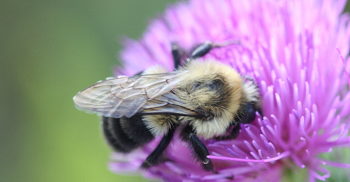What’s black and yellow and needs your help as a citizen scientist?
Kudos to you if you guessed bumble bees. It’s sad but it’s true that this genus of key pollinator is in danger due to human activities such as pesticide use, climate change, and habitat fragmentation. Loss of bumble bee diversity has huge impacts on ecosystems because many plants, including crops that humans rely on for food, require insect pollination. In fact, there is already evidence of a decline in insect-pollinated plant diversity in places such as Britain and the Netherlands, where multiple bumble bee species have gone extinct (The Xerces Society, 2018).
The good news is that you, your eyes, and your smartphone have the power to help scientists track and conserve North America’s bumble bees. Bumble Bee Watch is a citizen science project that allows individuals to observe bumble bees and report their findings to a public database. The data collected by the army of citizen scientists at Bumble Bee Watch allows researchers to track bumble bee distribution so that they can focus conservation efforts. These pollinators are so widely spread that tracking their distribution would be nearly impossible for researchers to do without your help.
By downloading their easy-to-use app (available for both iOS and Android), contributing to the Bumble Bee Watch database is easier than posting an Instagram. No smartphone? No problem! Just head to their website to sign up for a free account there instead. A flower garden would be a great place to start your hunt. Don’t sweat it if you have no previous identification experience, just do your best to take photos that clearly display face, thorax and abdomen colouration. (As a general ID tip, many bumble bees are yellow and black with large fuzzy bodies). After uploading your photos to the app or website, the project will help you identify your find. Answer a series of morphological questions that narrow down the list to a single species. Experts will then provide feedback on your ID to help improve your knowledge and ensure accurate species data is posted to the website. Anyone can access the interactive map to keep track of their own observations, as well as explore other sightings.
Every Bumble Bee Watch submission, whether it be of a rare and endangered, or common species, is extremely valuable. The bumble bee distribution data supplied by this network of citizen scientists is crucial for researchers to establish effective conservation strategies (for example, see Toronto's Pollinator Protection Strategy). By participating in Bumble Bee Watch, you will become part of a group dedicated to restoring bumble bee diversity in North America.
Here at EcoSpark, we empower people to take an active role in protecting and sustaining nature. We provide citizen science resources such as the Park Watch and School Watch guides, available at www.ecospark.ca. These resources introduce community volunteers and teachers to over a dozen citizen science project ideas for gardens, parks, and school grounds.
Emma is the Citizen Science Assistant intern at EcoSpark. She loves nature and is passionate about spreading the word about citizen science opportunities. During the school year, she attends Queen’s University where she is completing her Bachelor of Science degree in biology.



